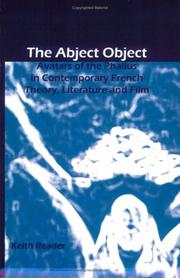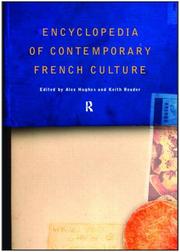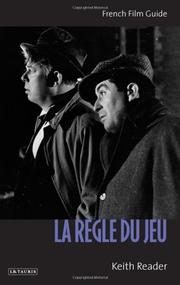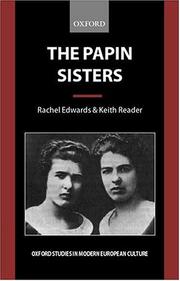| Listing 1 - 8 of 8 |
Sort by
|
Book
ISBN: 0340226315 Year: 1979 Publisher: London Hodder and Stoughton
Abstract | Keywords | Export | Availability | Bookmark
 Loading...
Loading...Choose an application
- Reference Manager
- EndNote
- RefWorks (Direct export to RefWorks)
791.43 --- Motion pictures --- -#SBIB:309H1320 --- Cinema --- Feature films --- Films --- Movies --- Moving-pictures --- Audio-visual materials --- Mass media --- Performing arts --- Filmkunst. Films. Cinema --- History --- De filmische boodschap: algemene werken (met inbegrip van algemeen filmhistorische werken en filmhistorische werken per land) --- History and criticism --- 791.43 Filmkunst. Films. Cinema --- #SBIB:309H1320

ISBN: 9401201730 142378913X 9781423789130 9789401201735 9042017295 9789042017290 Year: 2006 Publisher: Amsterdam ; New York, N.Y. : Rodopi,
Abstract | Keywords | Export | Availability | Bookmark
 Loading...
Loading...Choose an application
- Reference Manager
- EndNote
- RefWorks (Direct export to RefWorks)
This book addresses representations and constructions of masculinity in crisis in contemporary French culture by way of two important concepts - the phallus (largely but not solely in (a) Lacanian sense(s)) and abjection (Kristeva). Scrutiny of these concepts informs readings of a number of texts - literary (Bataille, Adamov, Doubrovsky, Houellebecq, Rochefort, Angot) and cinematic (Ferreri, Eustache, Godard, Noé, Bonello) - in which the abject phallus is a significant factor. The texts chosen all describe or stage crises of masculinity and mastery in ways that suggest that these supposedly beneficent qualities - and the phallus that symbolizes them - can often be perceived as burdensome or even detestable. Abjection is a widely-used concept in contemporary cultural studies, but has not hitherto been articulated with the phallus as emblem of male dominance as it is here. The volume will be of interest to those working in the areas of French, gender and film studies.
French literature --- Gender identity in literature. --- Gender identity in motion pictures. --- Masculinity in literature. --- Masculinity in motion pictures. --- Motion pictures --- Penis in literature. --- Masculinity (Psychology) in literature --- History and criticism --- Theory, etc. --- History and criticism. --- History.
Book
ISBN: 1781388040 1846316782 1846316650 9781846316784 9781781388044 9781846316654 9781846316654 Year: 2011 Publisher: Liverpool : Liverpool University Press,
Abstract | Keywords | Export | Availability | Bookmark
 Loading...
Loading...Choose an application
- Reference Manager
- EndNote
- RefWorks (Direct export to RefWorks)
Epicentre of the Revolution of 1789, erstwhile bastion of the skilled working-class and centre of radical agitation, along with Pigalle and Montmartre a focus for popular and raffish night-life in the early twentieth century, the Bastille area of Eastern Paris (also known as the Faubourg Saint-Antoine) is now an ethnically and socially mixed quartier which still bears the traces of its previous avatars. In a fascinating tour, Keith Reader charts the history and cultural geography of this unique area of Paris, from the fortress and prison that gave the area its name to the building of the largest and costliest opera house in the world.
Historic sites --- Heritage places, Historic --- Heritage sites, Historic --- Historic heritage places --- Historic heritage sites --- Historic places --- Historical sites --- Places, Historic --- Sites, Historic --- Archaeology --- History --- Historic buildings --- Monuments --- World Heritage areas --- Bastille. --- France. --- Bastille, Paris --- Bastilii︠a︡ --- France --- Faubourg Saint-Antoine (Paris, France) --- History.
Book
ISBN: 1800341245 1789625084 9781789625080 1789621046 9781789621044 Year: 2021 Publisher: Liverpool : Liverpool University Press,
Abstract | Keywords | Export | Availability | Bookmark
 Loading...
Loading...Choose an application
- Reference Manager
- EndNote
- RefWorks (Direct export to RefWorks)
The Marais was the beating heart of fashionable Paris from the Middle Ages through to the time of Louis XIV, when the court's move to Versailles marked the start of a decline in its fortunes. Thereafter it became a working-class, largely Jewish area, sometimes described as a 'ghetto', and by the early twentieth century was in a parlous condition from which it was extricated by the Paris City Council and the 1960s restoration plan of Andre Malraux (which did not go without criticism and opposition). Its most recent avatar has been as the best-known gay quartier of the capital, though again this identity has not been a straightforward or always easily-accepted one. The stress throughout will be on representations - literary, cinematic, autobiographical, photographic and in graphic-novel form - as much as if not more than the unfolding of historical events.
Marais (Paris, France) --- History. --- In popular culture. --- Jewish studies --- LGBT studies --- Cultural topography --- Urban studies --- Paris studies

ISBN: 0415131863 9780415131865 0203003306 9780203003305 9781134788668 1134788665 9786610110254 6610110255 1280110252 9781134788613 9781134788651 9780415263542 1134788657 Year: 1998 Publisher: London ; New York : Routledge,
Abstract | Keywords | Export | Availability | Bookmark
 Loading...
Loading...Choose an application
- Reference Manager
- EndNote
- RefWorks (Direct export to RefWorks)
More than 700 alphabetically organized entries by an international team of contributors provide a fascinating survey of French culture post 1945. Entries include:* advertising * Beur cinema * Coco Chanel * decolonization * écriture feminine * football * francophone press * gay activism * Seuil * youth culture Entries range from short factual/biographical pieces to longer overview articles. All are extensively cross-referenced and longer entries are 'facts-fronted' so important information is clear at a glance. It includes a thematic contents list, extensive index and suggestions for
History of civilization --- Sociology of culture --- anno 1900-1999 --- France --- Popular culture --- Culture populaire --- Encyclopedias --- Encyclopédies --- Biography --- Dictionaries --- Civilization --- Biographie --- Dictionnaires --- Civilisation --- 908 <44> --- #KVHA:Cultuur; Frankrijk --- Culture, Popular --- Mass culture --- Pop culture --- Popular arts --- Communication --- Intellectual life --- Mass society --- Recreation --- Heemkunde. Area studies--Frankrijk --- Encyclopedias. --- -Encyclopedias. --- Frankrijk --- Kunst --- cultuurgeschiedenis --- encyclopedieën --- geschiedenis --- 908 <44> Heemkunde. Area studies--Frankrijk --- encyclopedieën. --- Cultuurgeschiedenis --- Encyclopedieën. --- Geschiedenis --- Encyclopédies --- Pʻŭrangsŭ --- Frankrig --- Francja --- Frant︠s︡ii︠a︡ --- Prantsusmaa --- Francia (Republic) --- Tsarfat --- Tsorfat --- Franḳraykh --- Frankreich --- Fa-kuo --- Faguo --- Франция --- French Republic --- République française --- Peurancih --- Frankryk --- Franse Republiek --- Francland --- Frencisc Cynewīse --- فرنسا --- Faransā --- Franza --- Republica Franzesa --- Gallia (Republic) --- Hyãsia --- Phransiya --- Fransa --- Fransa Respublikası --- Franse --- Францыя --- Frantsyi︠a︡ --- Французская Рэспубліка --- Frantsuzskai︠a︡ Rėspublika --- Parancis --- Pransya --- Franis --- Francuska --- Republika Francuska --- Bro-C'hall --- Френска република --- Frenska republika --- França --- República Francesa --- Pransiya --- Republikang Pranses --- Γαλλία --- Gallia --- Γαλλική Δημοκρατία --- Gallikē Dēmokratia --- فرانسه --- Farānsah --- צרפת --- רפובליקה הצרפתית --- Republiḳah ha-Tsarfatit --- פראנקרייך --- 法国 --- 法蘭西共和國 --- Falanxi Gongheguo --- フランス --- Furansu --- フランス共和国 --- Furansu Kyōwakoku --- Francija --- Ranska --- Frankrike --- Culture --- France (Provisional government, 1944-1946) --- 1945 --- -France --- Dictionaries. --- 프랑스 --- Falanxi --- Fa-lan-hsi --- 法蘭西 --- Frant︠s︡ --- Франц --- Frant︠s︡ Uls --- Франц Улс --- Popular culture - France - Encyclopedias --- France - Civilization - 1945- - Encyclopedias --- FRANCE --- CIVILISATION --- -ENCYCLOPEDIES --- CULTURE POPULAIRE --- ENCYCLOPEDIES

ISBN: 9781848850545 1848850549 Year: 2010 Publisher: London Tauris
Abstract | Keywords | Export | Availability | Bookmark
 Loading...
Loading...Choose an application
- Reference Manager
- EndNote
- RefWorks (Direct export to RefWorks)
Renoir, Jean, --- Règle du jeu (Motion picture) --- Règle du jeu (Motion picture)
Book
ISBN: 0333361970 Year: 1987 Publisher: Basingstoke Macmillan
Abstract | Keywords | Export | Availability | Bookmark
 Loading...
Loading...Choose an application
- Reference Manager
- EndNote
- RefWorks (Direct export to RefWorks)

ISBN: 1280444878 0191541699 1423785789 9781423785781 9781280444876 9786610444878 6610444870 0198160100 9780198160106 0198160119 9780198160113 9780191541698 1383006989 Year: 2023 Publisher: Oxford : Oxford University Press,
Abstract | Keywords | Export | Availability | Bookmark
 Loading...
Loading...Choose an application
- Reference Manager
- EndNote
- RefWorks (Direct export to RefWorks)
This is a study of the 1933 killing by the Papin sisters of their mistress and her daughter. The book discusses the idea that the obsessive recurrence of the case makes it a prism through which to examine multiple aspects of French culture.
Murder --- Women murderers --- Murder in literature --- Criminology, Penology & Juvenile Delinquency --- Social Welfare & Social Work --- Social Sciences --- Female homicide offenders --- Murderesses --- Women homicide offenders --- Female offenders --- Murderers --- Criminal homicide --- Killing (Murder) --- Homicide --- History --- Papin, Christine, --- Papin, Léa, --- History.
| Listing 1 - 8 of 8 |
Sort by
|

 Search
Search Feedback
Feedback About UniCat
About UniCat  Help
Help News
News